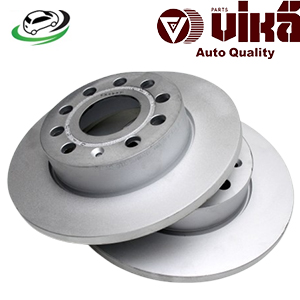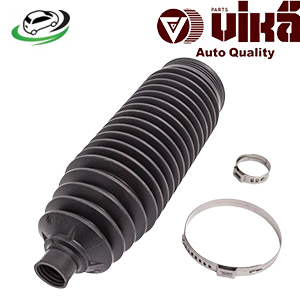-30%
Get Steering Rack Boot VW 337/20AE/Golf IV/Jetta IV/Jetta IV GLI/New Beetle 1J0422831B
The steering rack boot, also known as the steering rack gaiter or bellows, is a critical component of a vehicle’s steering system. It protects the steering rack and tie rods from dust, dirt, and moisture, ensuring smooth and precise steering. This comprehensive guide delves into the function, types, common issues, signs of failure, maintenance, and replacement of the steering rack boot.
Function of the Steering Rack Boot
The primary functions of the steering rack boot include:
- Protection: The boot shields the steering rack and tie rods from contaminants such as dirt, dust, and moisture, which can cause wear and corrosion.
- Sealing: It helps maintain the integrity of the lubrication within the steering system, preventing the loss of grease and keeping the moving parts well-lubricated.
- Flexibility: The boot is designed to accommodate the movement of the steering rack and tie rods, allowing for smooth operation and steering precision.
- Extend Component Life: By preventing contaminants from entering the steering system and maintaining proper lubrication, the boot helps extend the lifespan of the steering components.
Types of Steering Rack Boots
Steering rack boots come in various types, designed to meet the specific needs of different vehicles and steering systems:
- Material Composition:
- Rubber Boots: Made from high-quality rubber, these boots offer good flexibility and resistance to wear and tear. They are commonly used in many vehicles.
- Thermoplastic Elastomer (TPE) Boots: These are made from a durable and flexible plastic material that offers superior resistance to extreme temperatures and chemicals.
- Polyurethane Boots: Known for their durability and resistance to wear, these boots are often used in high-performance and off-road applications.
- Design Features:
- Universal Boots: These can be trimmed to fit a variety of vehicles and steering rack sizes, offering versatility and ease of installation.
- Model-Specific Boots: Designed to fit specific vehicle makes and models, these boots ensure a precise fit and optimal protection.
Importance of the Steering Rack Boot
The steering rack boot is crucial for several reasons:
- Preventing Contamination: By keeping dirt, dust, and moisture out of the steering system, the boot prevents wear and corrosion of the steering rack and tie rods.
- Maintaining Lubrication: The boot helps retain the lubrication within the steering system, ensuring smooth and efficient operation of the steering components.
- Ensuring Safety: Properly functioning steering components are essential for safe vehicle operation, and the boot plays a key role in maintaining their integrity.
- Extending Component Lifespan: By protecting the steering system from contaminants and maintaining proper lubrication, the boot helps extend the lifespan of the steering components, reducing the need for costly repairs and replacements.
Common Issues with Steering Rack Boots
Several issues can affect the performance and longevity of steering rack boots:
- Wear and Tear: Over time, the boot material can degrade due to exposure to heat, chemicals, and physical stress, leading to cracks or tears.
- Impact Damage: Hitting potholes, curbs, or debris can cause the boot to tear or become dislodged from its mounting points.
- Aging: Rubber boots, in particular, can become brittle and crack with age, especially in harsh environmental conditions.
- Improper Installation: Incorrect installation can lead to misalignment or gaps in the boot, allowing contaminants to enter the steering system.
Signs of a Faulty Steering Rack Boot
Identifying signs of a faulty steering rack boot can help address issues before they lead to more severe problems:
- Visible Damage: Cracks, tears, or holes in the boot are clear signs of damage that need to be addressed.
- Fluid Leaks: If the boot is torn or damaged, you may notice grease or steering fluid leaking from the boot area.
- Unusual Noises: Clunking or squeaking noises when turning the steering wheel can indicate a lack of lubrication or contamination in the steering system due to a faulty boot.
- Steering Issues: Difficulty in steering, such as stiffness or lack of responsiveness, can be a result of contamination or lack of lubrication in the steering system.
Maintenance and Prevention
Proper maintenance of the steering rack boot can help ensure its longevity and effectiveness:
- Regular Inspections: Check the condition of the boot during routine maintenance, looking for signs of wear, cracks, or damage.
- Cleanliness: Keep the area around the steering system clean to prevent dirt and debris from accumulating and causing damage.
- Use Quality Parts: When replacing the boot, use high-quality parts that are designed for your specific vehicle make and model.
- Avoid Impact Damage: Drive carefully to avoid hitting potholes, curbs, and other obstacles that can damage the boot.
Replacement of the Steering Rack Boot
Replacing the steering rack boot involves several steps, which can vary depending on the vehicle and steering system type:
- Preparation:
- Tools and Materials: Gather necessary tools, including a socket set, wrenches, screwdrivers, and replacement boot and grease.
- Safety Measures: Ensure the vehicle is securely supported on jack stands and the wheels are removed.
- Remove Old Boot:
- Disconnect Components: Remove any components connected to the boot, such as tie rods or steering linkage.
- Cut or Remove Boot Clamps: Use appropriate tools to cut or remove the clamps securing the boot to the steering rack and tie rods.
- Remove Boot: Carefully slide the old boot off the steering rack and tie rods, taking care not to damage any components.
- Install New Boot:
- Clean Surfaces: Clean the surfaces of the steering rack and tie rods to remove any old grease, dirt, or debris.
- Apply Grease: Apply a suitable amount of grease to the steering rack and tie rods to ensure proper lubrication.
- Position Boot: Slide the new boot onto the steering rack and tie rods, ensuring it is aligned correctly with the mounting points.
- Secure Boot: Use new clamps or zip ties to secure the boot in place, ensuring a tight and secure fit.
- Reassemble Components:
- Reconnect Components: Reattach any components removed during the process, such as tie rods or steering linkage.
- Reinstall Wheels: Reinstall the wheels and lower the vehicle.
- Test Steering:
- Inspect: Start the vehicle and turn the steering wheel to ensure smooth and responsive operation.
- Test Drive: Take the vehicle for a test drive to ensure the new boot is functioning properly and there are no issues with steering or fluid leaks.
Follow us on Facebook for more parts.



